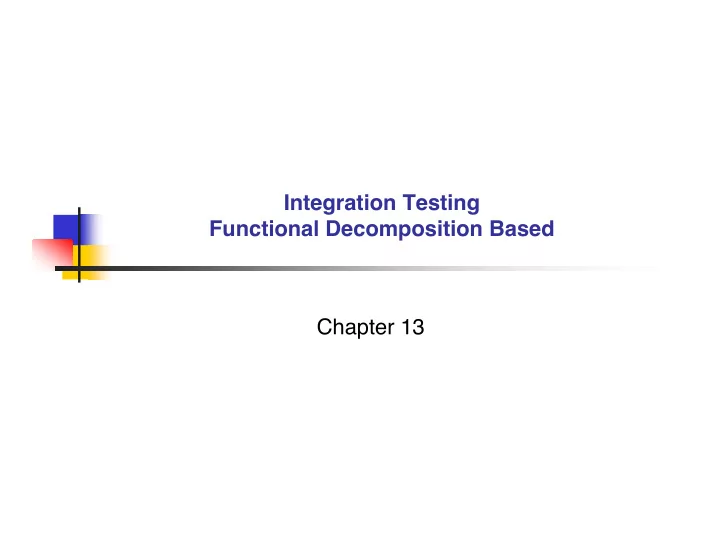

Integration Testing Functional Decomposition Based Chapter 13
Integration Testing Test the interfaces and interactions among separately tested units Three different approaches Based on functional decomposition Based on call graphs Based on paths IntF–2
Functional Decomposition Functional Decomposition Create a functional hierarchy for the software Problem is broken up into independent task units, or functions Units can be run either Sequentially and in a synchronous call-reply manner Or simultaneously on different processors Used during planning, analysis and design IntF–3
SATM Units Unit Level Name Unit Level Name 1 1 SATM system 14 1.3.1 Screen door A 1.1 Device sense & control 15 1.3.2 Key sensor D 1.1.1 Door sense & control C 1.4 Manage session 2 1.1.1.1 Get door status 16 1.4.1 Validate card 3 1.1.1.2 Control door 17 1.4.2 Validate PIN 4 1.1.1.3 Dispense cash 18 1.4.2.1 Get PIN E 1.1.2 Slot sense & control F 1.4.3 Close session 5 1.1.2.1 Watch card slot 19 1.4.3.1 New transaction request 6 1.1.2.2 Get deposit slot status 20 1.4.3.2 Print receipt 7 1.1.2.3 Control card Roller 21 1.4.3.3 Post transaction local 8 1.1.2.4 Control Envelope Roller 22 1.4.4 Manage transaction 9 1.1.2.5 Read card strip 23 1.4.4.1 Get transaction type 10 1.2 Central bank comm. 24 1.4.4.2 Get account type 11 1.2.1 Get PIN for PAN 25 1.4.4.3 Report balance 12 1.2.2 Get account status 26 1.4.4.4 Process deposit 13 1.2.3 Post daily transactions 27 1.4.4.5 Process withdrawal B 1.3 Terminal sense & control IntF–4
SATM functional decomposition tree 1 C A 10 B D E 11 12 13 14 15 22 F 16 17 2 3 4 5 6 7 8 9 18 19 20 21 23 24 25 26 27 IntF–5
Decomposition-based integration strategies What are the decomposition-based integration strategies? IntF–6
Decomposition-based integration strategies – 2 Top-down Bottom-up Sandwich Big bang IntF–7
Big bang integration process What is the big bang integration process. IntF–8
Big bang integration process – 2 All units are compiled together All units are tested together IntF–9
Big bang integration issues What are the issues (advantages and drawbacks)? IntF–10
Big bang integration issues – 2 Failures will occur! No clues to isolate location of faults No stubs or drivers to write IntF–11
Top-down integration What is the top-down integration process? IntF–12
Top-Down integration example Top Subtree Sessions 1-4 Second Level Subtree Sessions 5-8 Bottom Level Subtree Sessions 9-13 IntF–13
Top-Down integration process Strategy Focuses on testing the top layer or the controlling subsystem first The main, or the root of the call tree General process is To gradually add more subsystems that are referenced/required by the already tested subsystems when testing the application Do this until all subsystems are incorporated into the test IntF–14
Top-Down integration process – 2 Stubs are needed to do the testing A program or a method that simulates the input-output functionality of a missing subsystem by answering to the decomposition sequence of the calling subsystem and returning back simulated data IntF–15
Top-Down integration issues What are the issues? IntF–16
Top-Down integration issues – 2 Writing stubs can be difficult Especially when parameter passing is complex. Stubs must allow all possible conditions to be tested Possibly a very large number of stubs may be required Especially if the lowest level of the system contains many functional units IntF–17
Top-Down integration issues – 3 One solution to avoid too many stubs Modified top-down testing strategy Test each layer of the system decomposition individually before merging the layers Disadvantage of modified top-down testing Both stubs and drivers are needed IntF–18
Bottom-up integration What is the bottom-up integration process? IntF–19
Bottom-up integration example Bottom Level Subtree Sessions 1-5 Second Level Subtree Sessions 6-9 Top Subtree Sessions 10-13 IntF–20
Bottom-Up integration process Bottom-Up integration strategy Focuses on testing the units at the lowest levels first Gradually includes the subsystems that reference/require the previously tested subsystems Do until all subsystems are included in the testing IntF–21
Bottom-Up integration process – 2 Drivers are needed to do the testing A driver is a specialized routine that passes test cases to a subsystem Subsystem is not everything below current root module, but a sub-tree down to the leaf level IntF–22
Bottom-up integration issues What are the issues? IntF–23
Bottom-Up Integration Issues Not an optimal strategy for functionally decomposed systems Tests the most important subsystem (user interface) last More useful for integrating object-oriented systems Drivers may be more complicated than stubs Less drivers than stubs are typically required IntF–24
Sandwich integration What is the sandwich integration process? IntF–25
Sandwich integration example Sandwich 1 Sessions 1-3 Sandwich 2 Sessions 4-13 Sandwich 3 Sessions 14-15 IntF–26
Sandwich integration process Combines top-down strategy with bottom-up strategy Doing big bang on a subtree IntF–27
Sandwich integration issues What are the issues? IntF–28
Sandwich integration issues – 2 Less stub and driver development effort Added difficulty in fault isolation IntF–29
Integration test session A session is a test suite that tests one edge in the tree Each session tests the combining of two parts #sessions = #edges This is different from the textbook #sessions = #nodes – #leaves + #edges = 2 #edges – #leaves + 1 Alternately #sessions = #internal_nodes + #edges IntF–30
Integration work numbers For top-down integration #nodes – 1 = #edges stubs are needed For bottom-up integration #nodes – #leaves = #internal_nodes drivers are needed The number integrated units for top-down and bottom-up #integrated_units = #internal_nodes IntF–31
Integration work numbers For SATM have 32 integration test sessions Correspond to 32 separate sets of test cases For top-down integration 32 stubs are needed For bottom-up integration 10 drivers are needed For top-down and bottom-up 10 integration units IntF–32
Decomposition-based drawback What is the major drawback of decomposition-based integration? IntF–33
Decomposition-based drawback – 2 It is functionally based Has the problems of all functional testing How do we overcome the problems? IntF–34
Decomposition-based drawback – 3 It is functionally based Has the problems of all functional testing How do we overcome the problems? Move to structural-based testing IntF–35
Recommend
More recommend